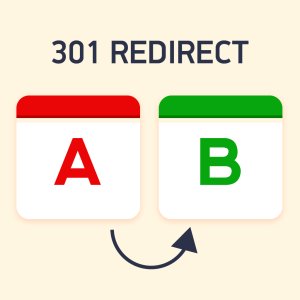Table of Content
Are you searching for technical online marketing terms that create confusion? Among all terms, 302 Redirect often raises questions in the mind of users. What is a 302 redirect? What are its uses and how does it impact marketing campaigns including search engine optimization. It is about letting your visitors and search engines know that a specific page you open has temporarily moved to a new page.
It is a notification that informs visitors about the movement of a page for short period. Redirection is a technical process that experts can handle, so they have to do this carefully to avoid mistakes. In case of any wrong redirect, it can affect your SEO. There are different types of redirects, so be careful when using redirects. When to use 302 Redirect and how it is different from 301 redirects?
Let’s find the difference between 302 and 301 redirects!
What is a 302 redirect?
302 Redirect is a process of telling visitors that the page has moved temporarily. It comes through an HTTP response and the purpose is to inform the audience about the redirection of the page.
What is a 301 redirect?
301 Redirect is also a term used for informing visitors that the page has moved permanently. No change will be expected after the redirect process has been completed.
The time is the major difference between both the redirects that also leave an impact on ranking. 302 Redirect is effective and better when compared to 301, as it maintains the rankings of a site on Google. On the other hand, you tend to lose ranking and there are chances of the site not being indexed. Search engines usually don’t appreciate 301 redirects, as it permanently moves a site.
Why use 301 redirects?
There are so many reasons to use 301 Redirects, whereas the top reasons are mentioned below.
- It is used when you change the name of your domain.
- It works when you experience that people approach your website using different URLs.
- You use it when planning to merge two web pages.
- You use it when changing from HTTP to HTTPS while merging two web pages.
- 301 redirect works when your page disappears from Google.
301 redirects take place whenever you delay the updates over at search engines. Google doesn’t index your site and 301 Redirect comes into action in such times when you just ignore the updates. On the contrary, 302 redirect is better for improving search engine optimization and gives a sigh of relief to visitors that the website will come back.
Reasons to use 302 Redirect
What are the reasons to use 302 Redirect? One should be aware of the benefits of redirects, as it is not a permanent strategy to redirect websites. Therefore, 302 Redirect is better and brings an improvement in SEO. Here are some top reasons to use 302 Redirect!
302 Redirects is good for UX
If you want to provide guidance to your visitors when they search for the content, you can create links so that they may click on the right options. The search results matter when 302 redirects come into place. The content quality also plays its role in improving UX, so that visitors don’t feel disappointed after looking at the content they need. It always improves the content display and you must not ignore it.
302 Redirects are not permanent
302 Redirect works temporarily, as it isn’t permanent. On the other side, 301 Redirect is a permanent change and entirely opposed to the first one. A user finds it flexible and ultimately it guides users to find the site link on a new page and that’s the advantage and reason for using this redirect. Furthermore, Google doesn’t remove your page from SERPs and you don’t affect your ranking.
302 Redirects doesn’t damage SEO
If you are serious about ranking your website, you find 302 Redirects so effective for your SEO campaign. It never affects your campaign and you keep on enjoying the rankings of your website. It is how you improve results on search engine pages with the implementation of this redirect.
302 Redirects are easier to tackle
Are you searching for implementation techniques for 302 redirects? You don’t have to work hard to implement 302 redirects. It is easier to manage and install. You just need a developer who has command over programming and can do it with ease. You can tackle and implement it after using Meta tags and plugins. It is easier to implement and remove, so never consider it a tough task.
When to Use 302 Redirect?
There is a clear difference between 301 and 302 Redirects, especially when we talk about the movement of the pages. A temporary move isn’t harmful from an SEO perspective, so one can consider this to make sense. Here are some reasons to use 302 Redirect!
When you want to move a page temporarily
The first reason is to make temporary changes. The top reason for using this redirect is to do temporary changes when you make any decision. You only use this redirect when you have plans to change the page of your site. You inform search engines about the necessary changes. You let visitors know that you are doing updates on the page before making it live. You want to get the feedback of the audience regarding a change to generate visitors. More importantly, you take this step to promote your business.
When you want to redesign or develop the page
Another important reason is to redesign the page when you use 302 Redirect. You let the audience know about the necessary changes regarding the development of your page. However, new development is a concern when you include this redirect process to make visitors clear about your online link.
With this, they don’t feel frustrated due to offline services. It tells them that website will come back soon. Sometimes, developers leave a message that the site will be back soon, or in some cases, they leave sign-up emails to remove their doubts.
When the page is broken or content missing
302 Redirect also becomes necessary when you know that some content on your web page is missing or links are broken. Whenever some of the page links are broken, the use of 302 Redirects works to inform visitors and search engines about the temporary move. If you have plans to publish the content again, then never use 301 Redirect. The best is to use 302 Redirect to update your visitors about the temporary changes in such a situation.
When the product is out of stock
If you are running an online store and are currently out of stock, you may use this redirect to let visitors know about the absence of products. Whenever your products are not available, this is the best strategy to inform your customers about the unavailability of stock. It’s a way to enjoy a win-win situation when you leave a message to your potential buyers when they open the site.
Conclusion
As expressed above, one can find several reasons to use 302 Redirects. Undoubtedly, 302 Redirect is used for temporary reasons to let search engines and audiences know that website has been moved to a new page. It is better than 404 errors or 301 Redirects, as this particular redirection is to aware the users of the content, product, or business that needs to be changed. It works, when the owner wants to redesign the website, update the content or have a plan to bring new products.






